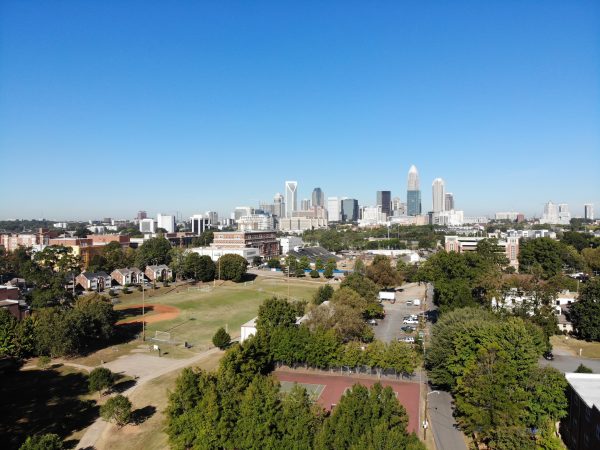Here’s what it would take for our park system to reach ‘the Disney model’

Parks in Charlotte can be a bit of a touchy subject. The system took a decade to recover funding and staffing levels after the Great Recession, and we’ve consistently placed near the bottom in national rankings for park space, spending and accessibility.
So last week, Park & Recreation Director Lee Jones laid out three scenarios for the future of Mecklenburg County’s parks: “standard,” “enhanced” and “showcase.” Jones called the third scenario, with a doubling of operational funding, “the Disney model.”
First, a quick look at where park funding is now. Local leaders have boosted funds for the Park & Recreation department in recent years, adding money to make up for inequality in where parks are placed, speed greenway construction and add staff for maintenance. Geographic inequality — with park facilities less likely to be placed in lower-income areas and communities of color — is a greater focus, with $2 million for park makeovers in low-income neighborhoods north and west of uptown. The county has also opened showcase parks uptown, including Romare Bearden Park and First Ward Park.
Since plunging by nearly half to 241 positions in the immediate aftermath of the financial crisis and recession, Park & Recreation is now up to 577 full-time equivalent positions. Many of those that have been added are part-time employees, however.
The county is currently finishing up Meck Playbook, the new master plan for parks. A final draft is expected to be complete in February, with county commissioners reviewing it this spring. There’s been a lot more emphasis on outdoor recreation in the past year, with gyms and most indoors activities closed due to covid-19 for long stretches.
But Charlotte in 2020 ranked 95th out of 97 U.S. cities ranked by the Trust for Public Land’s Parkscore, a widely cited system for assessing different communities. The ranking factors in access (how many residents live within a 10-minute walk of a park), acreage, spending per resident, and available amenities. Mecklenburg County fares poorly on all of those metrics. Some commissioners seemed to indicate they’re tired of seeing those poor scores.
“It comes up constantly, about our ranking,” commissioner Mark Jerrell noted at the board retreat.
Jones shared some of the Meck Playbook group’s preliminary analysis of Mecklenburg’s spending vs. five peers with similar populations, size and density.
Mecklenburg spends $3,077 per developed acre of park land (that excludes nature preserves and undeveloped acreage — spending per acre falls to $1,932 if you include those as well). The five peer cities spend substantially more, an average of $4,380.
Mecklenburg also has fewer full-time positions for park employees: 5.3 per 10,000 residents, vs. 6.5 per 10,000 residents in the five peer cities. The county would need 132 more full-time employees to match that average.

Jones presented the board with three scenarios for operational funding:
- Under the “standard” model, if parks continue to receive about $40 million worth of operating funds (which excludes one-time funds and some other revenues), the county would be able to fill current vacancies and perform responsive maintenance.
- Under the “enhanced” model, with a $17 million budget increase, the county would be able to perform preventative maintenance, remove more invasive species, and beef up athletic offerings and senior citizen programming. That operating budget would bring Mecklenburg in line with the five peer cities identified by Meck Playbook, Jones said.
- Finally, under the “showcase” model, the park system would receive double its current operating budget — a total of $81 million. Jones said that would enable the county to provide dedicated maintenance staff at every park, dedicated outreach staff, greater marketing and customer service capabilities, and comprehensive removal of invasive species across the county.
Jones called that “the scenario under which we could shine as a showcase park system amongst our peers.”
“The showcase model is what I call the Disney model,” he told commissioners. “You go to Disneyland, you’re there all day, everything is clean and beautiful.It closes, people go home at night, staff comes out and they’re working from 1 am until 6 am. Everything looks new and bright, every day.”
County commissioners will spend the next few months ironing out the details of next fiscal year’s budget, which they’ll adopt in June. There are likely to be a lot of priorities competing for limited dollars: Covid-19 relief for business owners and renters, aid for the homeless and funding for Charlotte-Mecklenburg Schools, to name a few. Plus, any additional taxes might be a tough sell as the community recovers from the pandemic’s economic aftershocks.
“I guess I get concerned when I hear these costs, and looking at whether we want to be a silver or gold or diamond recreation center when, in fact, we’re a human services agency,” said George Dunlap, chair of the board of commissioners, citing crises like people losing jobs and housing. “And then to think that we don’t want to raise taxes, that doesn’t leave a whole lot.”